Bovington Panther Tank
The camouflage pattern on this tank is very unusual. The reason is that this tank was produced after the Second World War.
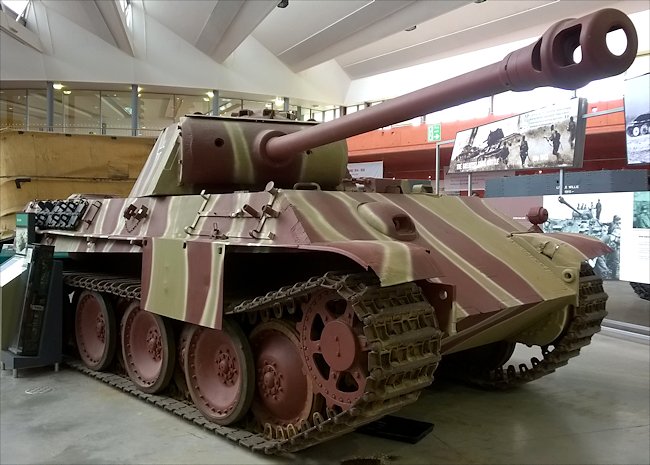
The factory in which it was being produced had been overrun by the Allies. It was completed under supervision of the British by the German workers who had been employed by the Maschinenfabrik Niedersachen Hanover (MNH) factory at the time of its capture. The new British management consisted of Capt. Hadlow and an NCO who deferred his discharge to complete the work. All the completion work was done by MNH skilled workers but it was not done at the Maschinenfabrik Niedersachen Hanover (MNH) factory. Production was moved to the gun factory at Laatzen south of Hanover as the MNH factory had being heavily damaged by late war bombing and did not have a roof. The gun Factory did have a roof. It took a lot of effort to shift the heavy machines, jigs and gun lathes.
Captain W.J. Hadlow REME instructed the completion of 9 Panthers and 12 Jagdpanthers, some like the one abandoned one one Pirbright Firing ranges lacked guns and mountings.
In May 1945 German industry was running out of everything including paint. The camouflage pattern you are looking on this Panther at Bovington Tank Museum is in fact read undercoat with a hasty camouflage pattern added from whatever leftover paint they had in their storeroom.
By just looking at the tank it is difficult to work out which model of Panther it is. Logic would tell you that it is one of the late-model Panther tanks as it was made after the end of the war but this is not completely true. It is a late-model Panther chassis but it has a recycled early model Panther tank turret.
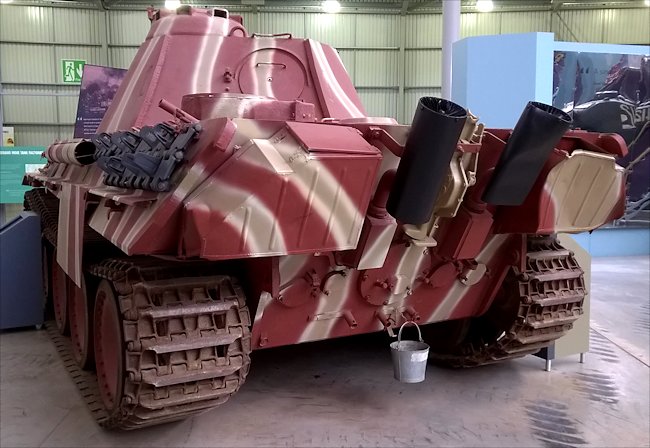
The engine hatch situated between the two air filters on the rear deck of the Panther tank is large. The tank engine could be lifted out by crane through these hatches. It is very surprising how physically small the Panther tank engine was but powered such a large heavy tank. It was another example of good German engineering design.
Inside the tank the gunner sat on the left-hand side of the 75 mm l/70 gun with the loader on the right and the commander at the rear. This is the exact opposite to the layout in American tanks.
One of the problems with the Panther tank design was that it was a very technologically superior combat vehicle compared with many of the Russian and Allied tanks, but if it broke down it was not easy to fix. The Russians particularly designed their tanks to be easy to make and to fix any mechanical defects on the battlefield.
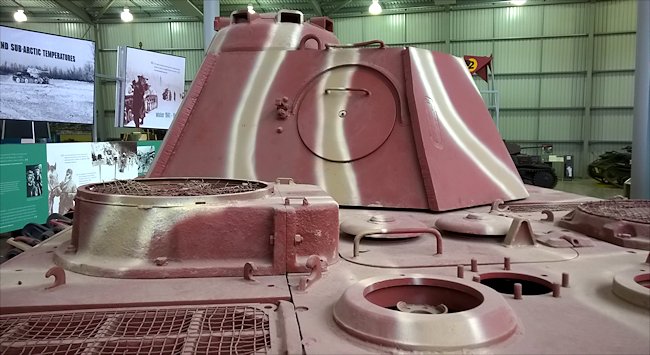
German design philosophy was to produce a tank that responded like a car and was easy to drive. The Russian T34 tank was designed to be good enough not fantastic. When you consider that the T34 operational service life before being knocked out in WW2 was only about three months there was no reason to waste limited resources on building a tank along the lines of a highly tuned sports car.
The Panzer V also took longer to produce. The Russians would have had 4 to 6 T34/76 tanks roll off the production line by the time German factories had finished building one Panther tank. In the end the superiority of tank numbers on the battlefields of Europe, for both the Russians and the Allies, was a very big factor in who won the war.
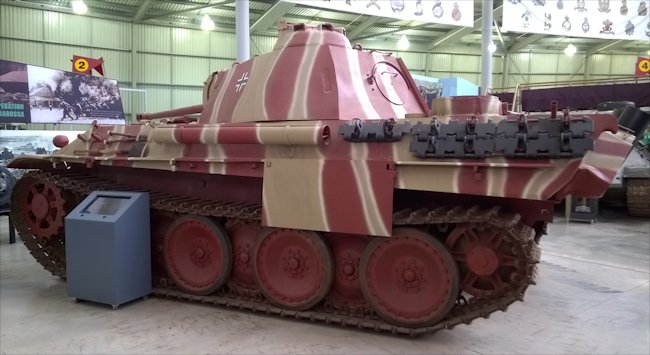
The Panther had larger escape hatches to facilitate quick exits when the tank was hit by enemy shells. Another good design feature on the Panther was that it had a greater ground clearance than the Russian T34 tanks. This meant that the belly of the tank did not get stuck in the mud as often as the Russian tanks. The Panther tank was better than any other tank when it was first produced but there were never enough of them to make a serious difference to the fighting in Russia, Italy or North West Europe.
The Panther required a tank crew of 6. Its maximum thickness of armour on the front was 80mm. It weighed 44 tonnes and was powered by a Maybach V12 23 litre engine that produced 700 horsepower. It traveled 0.8 mile per gallon of fuel (2.26 litres per Kilometre). This was a lot more economical than the Tiger thank that burnt five gallons of fuel per mile. It was armed with a 75mm KwK42 L/70 main gun and had two 7.92mm machine guns. It first entered service in 1943 and remained operational until the end of WW2 in 1945.
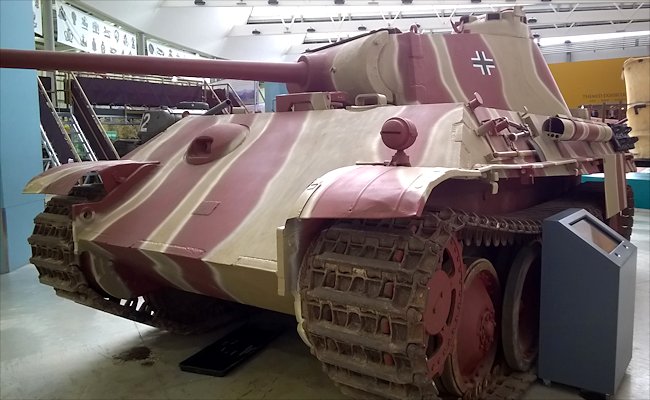
The Panther tank was not mechanically reliable
The German Panther tank was pressed into service very quickly without all the mechanical reliability problems being solved. 204 Panther tanks were sent to the battle of Kursk.
Six broke down before getting to the battlefield. By the 9th July 1943 German Army records show that 28 Panthers were lost, including those 6. By the 10th July 1943, out of those 204 Panther tanks 81 had mechanical failures that required them being towed back to the tank maintenance areas. They had a very bad reliability rate.
Where can I find other preserved Panther Tanks?
- Panther Ausf. A - Wheatcroft Collection, England
- Panther Ausf. A - Befehlspanzer Munster Germany (running condition)
- Panther Ausf. A - (n° 224) Auto + Technik Museum, Sinsheim, Germany
- Panther Ausf. A - (n° 243) Auto + Technik Museum, Sinsheim, Germany
- Panther Ausf. A - (n° 413) Private Collection, Germany
- Panther Ausf. A - (n° 256) Saumur Tank Museum France
- Panther Ausf. A - (n° 211) Saumur Tank Museum France (running condition)
- Panther Ausf. A - Omaha Overlord Museum, Colleville-sur-Mer, France
- Panther Ausf. A - 501/503e RCC Mourmelon-le-Grand France
- Panther Ausf. A - (n° 201) Royal Jordanian Tank Museum, Jordan
- Panther Ausf. A - Australian Armour and Artillery Museum, Cairns, Queensland.
- Panther Ausf. A - National Armor and Cavalry Museum, Fort Benning, GA,USA
- Panther Ausf. A - U.S. Army Ordnance Museum, Fort Lee, VA, USA
- Panther Ausf. A - The Collings Foundation, Stow, MA, USA (running condition)
- Panther Ausf. A - Canadian War Museum (CWM) in Ottawa Canada
- Panther Ausf. A or D Panzermuseum, Thun, Switzerland
- Panther Ausf. D - Breda Netherlands
- Panther Ausf. G - Bovington Tank Museum England (British Built)
- Panther Ausf. G - Wehrtechnische Dienststelle, Trier, Germany (British Built)
- Panther Ausf. G - Privately owned now confiscated by police, Germany (British Built)
- Panther Ausf. G - National War and Resistance Museum, Overloon Netherlands
- Panther Ausf. G - Houffalize Belgium
- Panther Ausf. G - Grandmenil Belgium – engine, gearbox and transmission are present
- Panther Ausf. G - Celles Belgium
- Panther Ausf. G - (n° 332) Saumur Tank Museum France
- Panther Ausf. G - Kubinka Tank Museum Russia (running condition)
- Panther Ausf. G - U.S. Army Ordnance Museum, Fort Lee, VA, USA
- Panther Ausf. G - 2x National Armor and Cavalry Museum, Fort Benning, GA, USA
- Source - Pierre-Oliver Buan - http://the.shadock.free.fr/Surviving_Panzers.html
WW2 tank books

